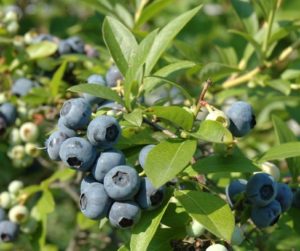Blueberry Tifblue Rabbiteye
Vaccinium ashei ‘Tifblue‘
Characteristics
- USDA Zones 7 – 9
- Full Sun
- Chill Hours: 550 – 600
- Well-Drained Soil with pH of 4.0 – 5.5
- Native to Southeastern US
- Small-Medium Berry Size
- Harvest Late June – July
- No major pests identified on Tifblue
Culture
The Tifblue rabbiteye blueberry is not self-pollinating; it will need a cross-pollinator to produce fruit (Brightwell and Brightblue are recommended). Because rabbiteyes ripen unevenly within a fruiting cluster, pick individual berries over a period of 4 to 6 weeks. Fruit size is small to medium with good color, picking scar, firmness, and flavor. Berries are very tart and tend to cling to the plant until fully ripe, facilitating both hand and mechanical harvesting. Berries do not ripen further after harvest; for maximum flavor and minimal bitterness, allow them to ripen on the bush. One full-size Tifblue rabbiteye blueberry plant can produce up to 15 pounds of berries per year and is an excellent choice for organic or EarthKind® orchards.
Noteworthy Characteristics
The best blueberry for Texas is the rabbiteye blueberry (Vaccinium ashei) and the Tifblue variety is a preferred favorite. Rabbiteye blueberries are native to the Southeastern United States and the humid woodlands of East Texas are typical of their native habitat. The Tifblue cultivar was developed by the University of Georgia and was released in 1955.
Problems
- Berries are tart if not fully ripe
- Rabbiteye blueberries do not tolerate alkaline soil or water
- Not drought tolerant, drip irrigation should be provided
- Sensitive to excessive fertilizer and to some types; apply fertilizer only 2 or 3 times a year at low rates. Organic and slow-release synthetic fertilizers are preferable.
- Tifblue was once the favored variety for the commercial rabbiteye industry because of its high yields and vigorous growth. However, newer, early ripening varieties with larger, high quality fruit that doesn’t spit during wet weather have replaced it as a commercial variety. However, Tifblue still remains the standard to which other varieties are compared.
Uses
Tifblue produces delicate bell-shaped white flowers in the spring that bees will love. Leaves turn burgundy red for outstanding seasonal color in the fall. Ripe fruit is sweet and flavorful and is ideal for fresh eating, baking, and making jam or jelly. Tifblue berries also freeze well.
